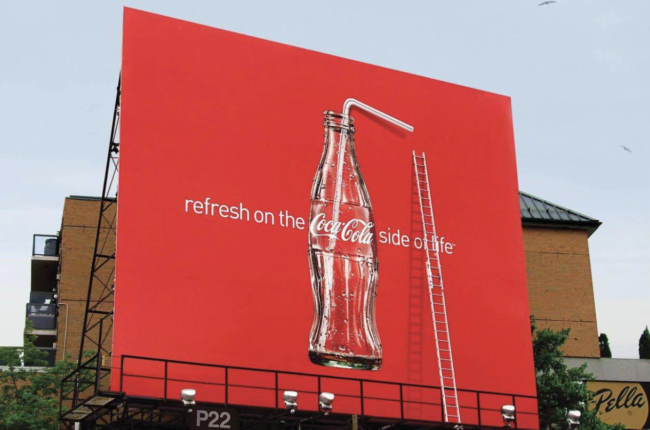Coca-Cola by name alone is one of the most iconic drinks in the world. It’s the first thing you see on the beverage shelves in stores, and it appears on billboards, commercials, clothing, furniture, refrigerators and so much more. Whenever in proximity with anything related to Coca-Cola, that vast red color and bright cursive writing glares at you and urges you to “enjoy Coke”–it reels you in and sparks a question that leads you to ask yourself, “What could such a prolific and recognizable drink actually taste like?” I have continually asked myself this question throughout my life, since I have always been intrigued by the brand’s undeniably impressive franchising, popularity, and most importantly, audacity to remain a crucial part of our world’s past, present and future.
To gain an understanding of Coca-Cola’s taste, I decided that reading the back of the bottle’s label just wasn’t enough to understand what truly went into making this drink. Though the actual recipe is a “trade secret,” it starts with coca leaves and kola nuts, which are both sources of caffeine. Originally, these surprisingly natural ingredients were mixed with sugar and carbonated water, which was sold as a medicine dubbed Coca-Cola. Specifically, North American Coke began its production with high fructose corn syrup (HFCS) instead of sugar, since it was more convenient for the brand. I confirmed this overwhelming sweetness when I first tried a Coke in New York: it had a peculiar taste at first but became craveable because of its “caramel” flavor. I wondered if it tasted different or better in other states, but it ended up tasting all the same throughout the US. The journey did not end in America for me.
Though Coke is made with the same recipe in every country, each country’s sugar source is different, which inspired me to give Mexican Coke a try. Mexican Coke is made with cane sugar rather than HFCS, and this makes it taste significantly different (and overall better) than North American Coke –it was more root beer and sarsaparilla-esque. Mexican Coke bottles are also larger than the bottles in America, this not only gives Coke a more elegant, nostalgic look but also serves people twice the amount of Coke. In fact, bottles, portions and propaganda of Coca-Cola only get bigger in other countries like Venezuela and Japan.
My mom went to Venezuela twenty-five years ago and discovered huge billboards and songs that were produced and sung about Coca-Cola. She was so taken aback by the publicity of the drink that she brought back a glass bottle filled with over a liter (33.81 ounces) of Coca-Cola for my grandparents to enjoy; what was most fascinating was the beauty of the bottle. It was contoured and much wider than the bottles I had tried and seen in America and Mexico. Its ingredients were also very similar to Mexican Coke, as Coke in Venezuela is also made with cane sugar.
French Coke is more traditional than the original recipe. In fact, the French use the original recipe from 1886, which uses kola concentrate, caramel color and flavor, as well as carbonated water. But instead of HFCS as its sugar source, France uses sucrose. Sucrose is real white “table sugar that is found in fruits, but along with fructose also comes from sugar beets and canes, versus fructose which is a much sweeter and more popular resource for various soft drinks and candies. Both HFCS and sucrose are processed very differently in the body and no sugar is better than the other in terms of health, however, sucrose has a more genuine taste than fructose. In my opinion, this makes the taste of Coke in France delicious, and it’s all because of the kind of sugar that is used.
In Japan, Coca-Cola is arguably more popular and beautiful than it is anywhere else. The taste is reminiscent of both American and Mexican Coke because it uses both natural sugar from the cane but also HFCS. It is also darker than any other variation of Coke I’ve seen. It is sold everywhere from supermarkets to street carts; in fact, there are streets dedicated solely to unpacking bottles and bottles of Coca-Cola. Japan has also created flavors of Coca-Cola that are not available in America and various other countries, such as peach, strawberry, apple, orange, grapefruit, root beer float and green tea. Though I did not get to try all of these flavors, the green tea along with the root beer float flavors were absolutely remarkable. The green tea Coke tasted like a scoop of caramel ice cream sprinkled with flakes of green tea, and the vanilla root beer float was like a giant ice cream sundae submerged in Coca-Cola. Japan was the most memorable tasting place out of all the locations I explored Coca-Cola in.
And so my lifelong question of “what could such a prolific and recognizable drink actually taste like?” is answered. Though the recipe is only known by a handful of people and the formula is the same in every country, its taste is defined by its sweetener. Whether it’s from a sugar cane farm, a bottle of high fructose corn syrup, granulated sugar on a table or extracted from coca leaves, the type of sugar is the defining ingredient of Coca-Cola. So if you are in North America, Mexico, Japan, Venezuela or France, I urge you to “enjoy (the many different versions of) Coke.”






